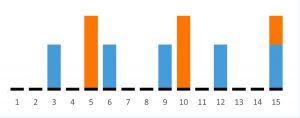1a) Own numberrythms
- Divide into groups. Each group is assigned a different number (3, 4, 5 or 6).
- The groups are tasked with planning their own clapping series based on their numbers. The group’s number indicates how many claps the series should consist of, but the claps may hit the thigh, abdomen, head, etc. in any order. The only rule is that the last clapping should be a regular clapping with your hands.
- The members of each group practice clapping through their series smoothly one after the other. For example, the members of group 5 should clap like this: 1-2-3-4-5-1-2-3-4-5-1-2-3-4-5, etc. Make sure that there is no break between fifth and first clap and that the clapping rhythm continues without interruption. Practice should be carried out until all groups know their clapping series by heart and can complete it without interruption.
1b) Ready-made rhythms (alternative arrangement)
- If the time reserved for the task is limited, you can simply skip the part where the groups come up with their own clapping series. Instead, ready-made series can be used.
- 3 pats: thigh – thigh – hands
- 5 pats: thigh – thigh – chest – ribcage – hands
- Students get to practice both series.
- The class is divided into two groups: one prepares to perform the series of three clapping, the other the series of five clapping.
2) Clap together
- Two groups are selected, for example groups 3 and 5. The groups must carry out their clapping series at the same time. Both groups should start clapping at the same time and stick to the same pace.
- What kind of rhythm is formed by the clapping of the groups? Does the last clapping of hands occur at the same time or at different times in different groups? It may be noted that the last clap often occur at different times, but sometimes they occur at the same time.
- After how many claps do the last claps with the hands occur again at the same time? The teacher can help and call out the first clapping (immediately after the first simultaneous clapping). Everyone counts together and concludes that the correct answer is 15, which is the lowest common multiple for the numbers 3 and 5.
- Try two other groups. What numbers do you come up with as the lowest common multiples for these two numbers? Which rhythm sounds the most fun? What happens if three or four groups clap at the same time?
3) Draw the rhythms
- Start by drawing 15 horizontal lines next to each other on the board. Ask group 3 to come up to the board and draw a tower above every third line. When they are finished, ask group 5 to draw a slightly taller tower above every fifth line.

- At which line do the towers first appear above the same line? (Group 5 can also draw their towers behind the towers of Group 3.)
- Try clapping the rhythms using the picture created on the board.
- Is it easier now?
- Draw out other rhythms in the same way.
The idea is taken from Lumatikka’s material.
